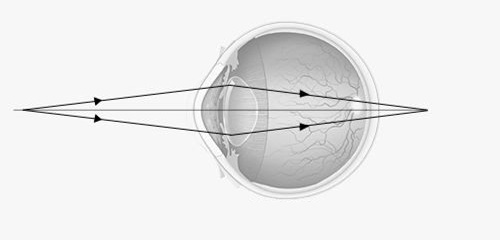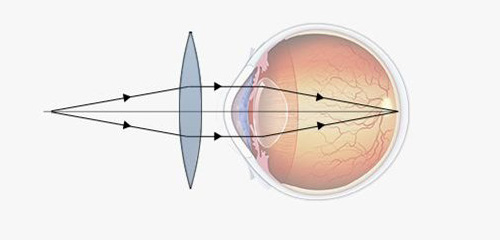Presbyopia
WHAT IS PRESBYOPIA?
Presbyopia, otherwise also called the ageing eye condition, affects patients over the age of 40, even those who didn’t need glasses their entire life. It is not a refractive error, but a physiological loss of the eye’s ability to accommodate - to focus on close distance. Presbyopia can cause problems when reading, working on a computer, then later when looking into the distance (watching TV, driving).
It appears among the 40th and 45th year of life, while in farsighted patients it tends to appear even earlier. Its first sign is a blurred vision and the inability to focus on shorter distances. Presbyopia gets worse with age and peaks at around sixty years of age, when it becomes stabilized and doesn’t get worse anymore.

Presbyopia

correction of Presbyopia
How to get rid of presbyopia
Presbyopia is usually corrected with reading glasses, but this is only a short-term solution. The disease is constantly progressing and after initial problems with vision at short distance, long and medium distance vision becomes worse as well.
When surgically removing presbyopia, the doctors use a variety of methods. Each surgery is preceded by a preoperative examination, after which the doctor determines the most appropriate method for the treatment of presbyopia.
-
PRELEX method: intraocular surgery, during which the patient’s lens unable to accommodate is replaced by an artificial multifocal lens that allows for good short- and long-distance vision. Intraocular surgery also serves as a prevention of the onset of cataract and reduces the risk of developing traumatic glaucoma.
-
Presby LASIK: a variant of the Lasik method, in which the excimer laser shapes a profile on the cornea for long- and short-distance vision. The effect, however, is often only temporary.
-
Corneal implants: they create an area for short-distance vision in the center of the cornea. The effect, however, is not sufficient and the implant is often removed due to scarring in its surrounding area.
- Monovision: a process in which one eye is modified by laser for long-distance vision and the other for short-distance vision. However, depth (3D) perception is partially eroded after the application of this method.
the surgery is outpatient, you go home after
- the procedure is not painful
- it only takes 20 minutes
- very fast recovery
- improved vision on the second day
- stabilization of quality vision within a few weeks.
WHO IS THE SURGERY SUITABLE FOR
Any patient who has presbyopia - the ageing eye condition, can undergo the surgery. The patient’s suitability for the surgery, however, depends on their age, profession, the progression of the defect and other eye disorders (glaucoma, retinal disease, ...).
During the initial examination, it is necessary to consult with a doctor what result you expect from the surgery - whether you are interested in getting rid of the glasses for good or whether you won’t mind their use for a certain distance (PC, reading ...). The respective intraocular lens will be used on this basis.
ARE YOU INTERESTED IN A CONSULTATION OR EXAMINATION?
Make an appointment today







